Bow Wave of the Kraken
2023-11-12
Renegade Legion /
RL Leviathan /
Review /
Game Design /
Spaceships /

Admiral Catalus had the the gall to suggest alien slaves respond better to incentives than beatings. Now, sentenced by the Terran Overlord Government [TOG] to lead his co-conspirators against the Renegade Legion until they successfully die a noble warrior's death, he takes command of the 21956th Kraken battleship squadron. Their destination, the frontlines of the Shannedam county offensive in the war with the Commonwealth and Renegade Legion
Wake of the Kraken is a campaign supplement for Renegade Legion: Leviathan consisting of 15 sequential scenarios. One player takes command of the Kraken squadron throughout the campaign, comprised of:
- One Ultor class Battleship Kraken
- Two Syracuse class cruisers Sicarius Brutus and Zeta Herculis
- One Bantha class frigate Peregrine
- Two Fulgur class destroyers Sopra Crassus and the Fulgur
- One Serpens class destroyer Dragon Gerhart
- all their various carried strike craft
The opposing player runs the Renegade Legion and Commonwealth forces at various battles with the Kraken squadron. Damage, with slight field repair, and munition expenditure persist for the Kraken and friends with only two scheduled resupplies throughout.
There's a few fundamental problems with this campaign, sadly. They make more sense if we start by looking at one of the scenarios first.
Mission 1: "Any Target"
A simple convoy raid. A training wheels mission. The full might of the Kraken squadron, though the heavier elements arrive 2 turns later, attacking a convoy of 8 merchant freighters bound for a local trade hub. The convoy is escorted by 3 Renegade Legion destoyers and simply need to make it across the board alive. The destroyers have a further goal of disabling any of the TOG ships.
The merchant vessels can be placed anywhere along the far edge, but there's an obvious optimal placement. It ends the scenario as soon as possible while keeping out of reach of the heavier TOG ships at all times.
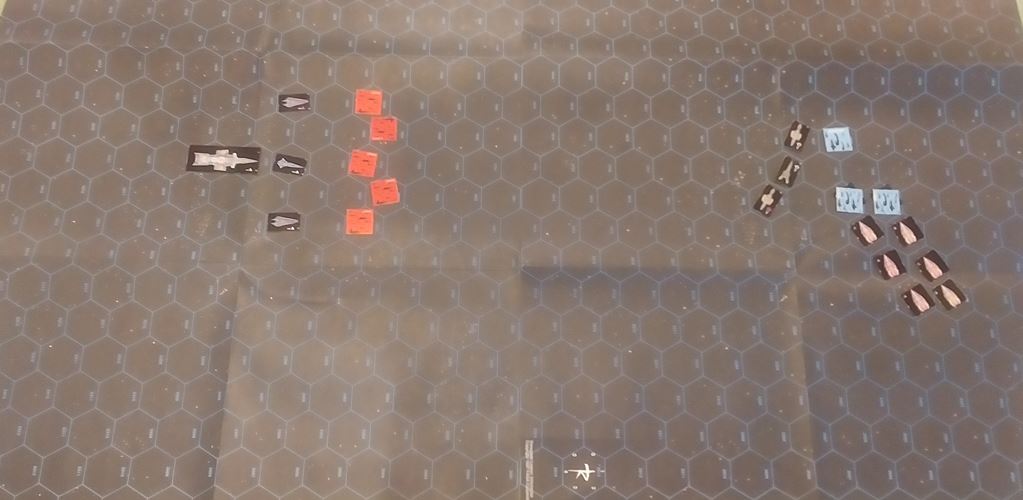 The end of turn 1, merchant convoy accelerating for their lives and the destroyers screening, while the TOG forces being to spread out and match course for broadsides.
The end of turn 1, merchant convoy accelerating for their lives and the destroyers screening, while the TOG forces being to spread out and match course for broadsides.
They deploy in two columns of 4 adjacent freighters with a velocity of 2, on a heading at an angle towards the far corner of the board. They have weapons in the strictest sense, but so low powered that the best they could ever hope to do is slightly degrade a fighter formation. So instead, per the scenario rules, they divert all power to engines and dump it all into velocity. The board is 26 hexes across, they're moving across the columns so they have to make a sharp turn, but the simple math of it is is that increasing to velocity 5 turn 1, 8 turn 2, and then using their thrust to change heading on turn 3 means they can exit the board and thus end the mission before the combat phase of turn 4.
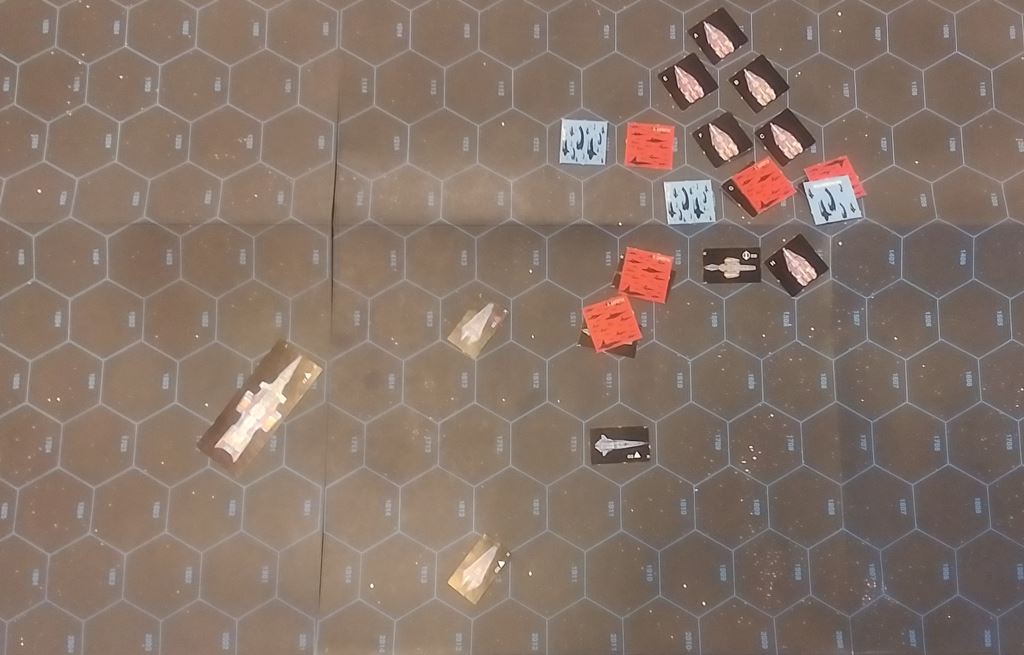 Turn 2, after movement, before combat. Some deft piloting has the destroyers out of the starboard broadside arc of the Peregrine, but we're all in missile range now, and the fighters are wreaking havoc.
Turn 2, after movement, before combat. Some deft piloting has the destroyers out of the starboard broadside arc of the Peregrine, but we're all in missile range now, and the fighters are wreaking havoc.
The battleship and cruisers enter from the bottom board edge with a starting velocity of 4. If the freighters start in the opposite far corner, it is literally impossible for the heavy ships to enter firing range with their lasers or fighters, and while the Kraken could fire a missile salvo, it's a huge waste of resources and probably a trade the Renegade player is happy to make.
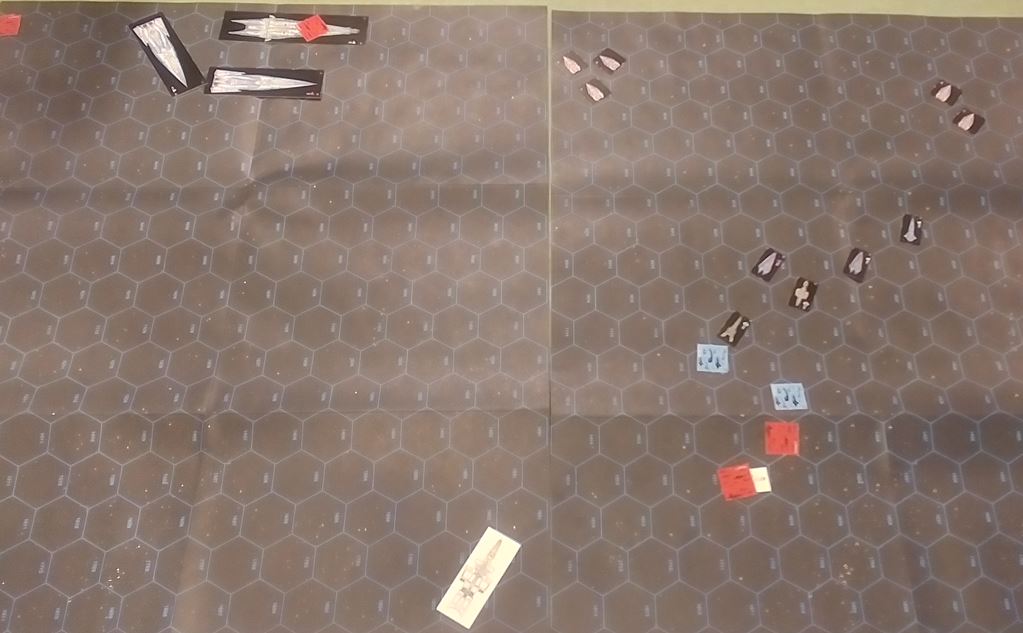 Turn 3, after capital movement, before fighter movement. The merchants have split into to two groups, largely because the ones headed towards the battleship and cruisers all had their maneuvering thrusters wrecked and were unable to make the heading change.
Turn 3, after capital movement, before fighter movement. The merchants have split into to two groups, largely because the ones headed towards the battleship and cruisers all had their maneuvering thrusters wrecked and were unable to make the heading change.
There's two ways you can play the defenders here. Either close in protection of the merchants, or try to engage the TOG forces early. Due to the difference in heading and velocity to start, trying to engage them early means you have two turns (1 & 2) to attack before the TOG ships speed past and are upon the merchants. Trying to stick to the merchants means you have two turns (2 & 3) to attack TOG because they're out of range turn 1.
Either way, there's not much flexibility in overall strategy, and it's mostly down to dogfight positioning and outguessing your opponent's arcs. Except the Ajax brought a gun to this knife fight.
First Fundamental Problem: Missiles
The Kraken squadron suffers attrition, including expended missile salvos. With only a few exceptions, the Renegade Legion has new fresh units every single mission. They have no incentive to conserve missiles. And that's the key right there. Missile superiority.
The Legion destroyers have 50pt salvos on the Exeter DDs and a 100pt salvo on the Ajax DD. Fire the 50s after a destroyer each to tie up their turrets and point defense, anyone one of which could strip the armor right off the hull if it slipped through. Then fire the 100pt salvo last and either it strips the armor off if the Peregrine is lucky, or as in our case, it blows clean through and dumps 60 points of damage into internal systems; a one-shot guaranteed kill.
Missiles are so incredibly deadly, especially in coordinated volleys, that the Renegade Legion's lack of consequences for dumping magazines each scenario makes for perpetually lopsided battles.
Compare the following ships. These were the most damaged ships that weren't hit by missiles.
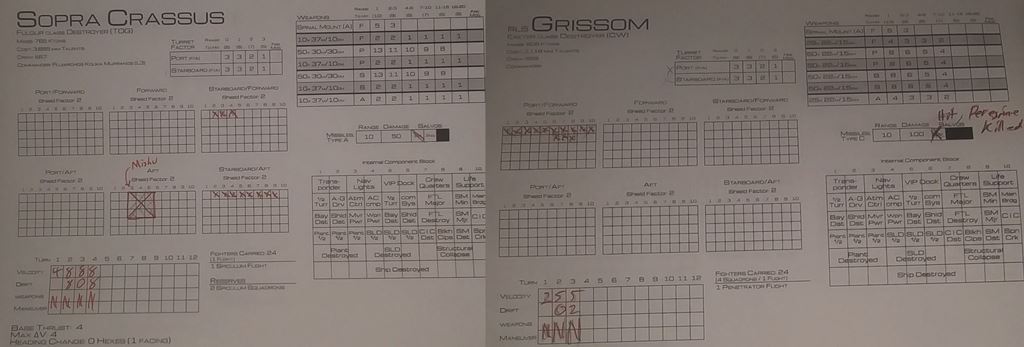
While these were the only two ships that suffered missile damage, both of which immediately died.
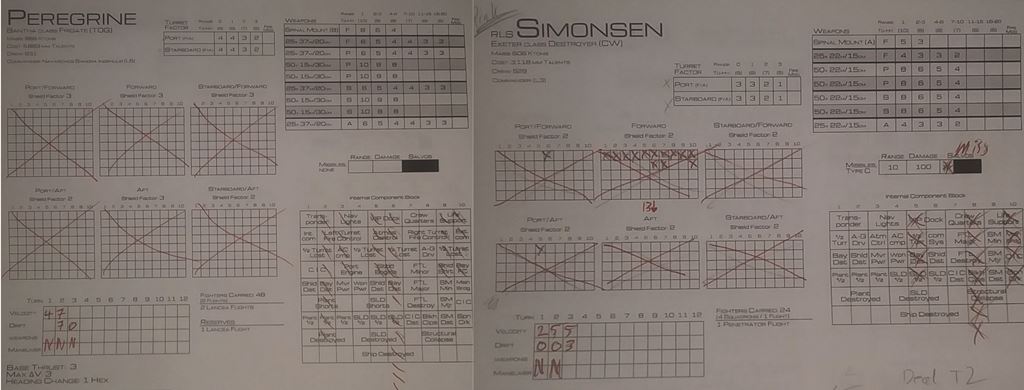
It's so bad, that it commits the cardinal sin of wargaming; you can win a game during unit selection. The most type E missile ships per ton fielded wins. Unforgivable.
Second Fundamental Problem: Asymmetrical Attrition
So in our campaign, the Peregrine bit it. Sure, the Legion lost a destroyer, but that has literally no impact on anything, no victory points for the TOG player, no loss of points for the Renegade player.
There's a major problem in that the Peregrine is key to both of the next two scenarios. In 'Destroyer Action', its loss represents a third of the fire power and 40% of the fighter capacity on the TOG side. The Peregrine has a scripted moment when it leaves the fight on turn 6 to go help the Kraken in mission 3, but again that's not going to happen. The rules allow you to sub in a lower tonnage-class vessel, but that means you get nothing in the second mission, and a mere destroyer in the third mission, 'Absence of Help', wherein the Kraken by its lonesome self faces a superior battleship AND a cruiser (the Peregrine would have come in on turn 3 at high velocity to assist).
It's just a slog of pain, with no benefit ever won beyond a vague point count. And yes, that's the narrative, but it's not nearly as fun to play as it might be to read. If you want to ignore the attrition aspect and play each mission with both sides fresh, you'd have more interesting individual scenarios, but it wouldn't be much of a campaign.
Third Fundamental Problem: Scenario Objectives
Mission 1 was a substantial victory for both sides, 6 freighters destroyed, but the Peregrine destroyed as well. Looking at the mission parameters for 'Destroyer Action', scenario length is "until TOG ships leave the map" and the victory conditions are comparative damage with no penalty for a draw. So down the Peregrine, why fight and probably lose when you can essentially skip the mission by entering the board on a heading ready to turn and then come about ASAP and leave before anything is in weapon range?
And then mission 3 is the exact same thing again. If you aren't likely to win, just don't fight it and wait for a scenario you think you can.
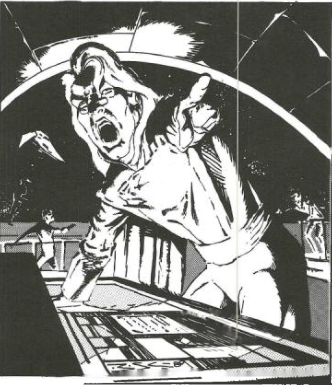
I hadn't prepared the materials through mission 4 because I thought no way would we get there, so we called it and just started brainstorming what missions are effectively skippable and which you actually have to play. Only a handful require the Kraken squadron to risk itself.
Beyond this glaring problem, many of the specific objectives either offer no penalty or outright reward the Renegade player for wasteful suicide attacks against the TOG forces.
A Fluke, Surely?
I've played four games of Leviathan now. One solo match of Destroyer Action to make sure I understand the rules which isn't worth discussing, and two with my 11yo son giving strategic orders for the OpFor while I conducted the tactical movement and combat resolution of both sides. Neither of those games played much different.
The first time we ran the scenario, everyone went dispersed in formation and 50 salvo missiles devastated both side's Destroyers. Fighters dove into a furball in the middle and mutually annihilated each other. The stragglers then were quickly whittled down from bay fire until only the Groups were left and they in turn cracked the spines of two ships by attacking damaged sides turned away from the opposing capitals before they went down. By turn 6 there were no fighters left on the board. We called the game at turn 7 because the Fulgur, Dragon Gerhart, Orestes, and Vaber were all flaming wrecks and the Serpens was flying off the table at velocity 6 with no bridge crew. The Triton and Peregrine were both starting to take internal damage and with the Peregrine breaking off, the game was going to be 4 more turns of pecking at each other with little hope of real damage.
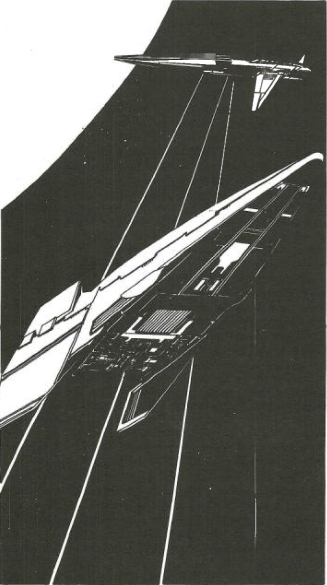
The second game, formations were much tighter and subsequently missiles were a multi-salvo affair and a game of careful consideration of when to hold and when to fire turrets. The Triton's salvo was entirely eliminated by turrets and shields, the Orestes as well, but then the TOG forces missed some rolls and the Peregrine took 80 points of damage to all the rear facings (which also brought up some questions about permitted missile flight paths). Meanwhile, Fighters from both sides flew past each other to form tall stacks to both draw missile fire which didn't happen, and concentrate fire on one face which killed the Peregrine on turn 3 and the Triton on turn 4. By turn 5, there were few Fighters left, the Sopra Crassus' missile cells were empty with nothing to show for it, while the Destroyers were weaving around each other angling for weak faces and exchanging laser fire. We called the game before turn 6 for time, but it was a slaughter neither of us considered a victory.
I can't figure out how people are making it past the first few missions when every time I play the first two, the Kraken ships are losing ships every time.
Design Own-Goals
I'm having a hard time properly understanding what the design goal was with Leviathan. Coordinated missile strikes backed up by Fighter control of airspace is what you get from the rules, which sure, that works, it's like a modern blue water navy game then. But then why waste so much time and space and rules on the things that don't really matter like the bays and spinal weapons? I can only accept a mix of institutional incompetence and stagnation on the part of the TOG so far, and then it completely falls apart when none of those constraints apply to the Commonwealth.
I suspect one of three things happened, in order of increasingly likelihood. They never playtested Leviathan and Kraken at all (except there's a list of nine named playtesters in the rulebook). They ignored the playtesters out of either hubris or disdain. Or they made last minute changes based on playtesting without then playtesting those changes just before publishing.
Ultimately I'm not sure it really matters. 'You can only be graded on the work you submit.'
 In the middle of my missile salvo turn, Dr. Tree said to me "Wait a minute, I've read this light novel before!"
In the middle of my missile salvo turn, Dr. Tree said to me "Wait a minute, I've read this light novel before!"
I want to play the game the Leviathan art is presenting, but I'm increasingly thinking you get there by entirely redesigning the game and campaign. But it's very tempting to just keep iterating on what's already there. Make missile salvos declare a fire mode, penetration or saturation, and either do damage in a wedge to one facing, or spread the total damage out evenly over adjacent facings. Replace named fighter squadrons with more generic 'recon/defense/attack/intercept fighter' tokens with more sensible stats. Move the damage track to a multidirectional block that sits inside of the rearranged armor blocks. Replace turrets and the paltry secondary bays with 'fast tracking bays' capable of operating in either point defense or anti-capital mode.
That's no small amount of work. Next time, Leviathan's influence on later capital ship wargames like Battlespace, Saganami Island Tactical Simulator and Star Blazers Fleet Battle System, and what refinements can be found for Leviathan.